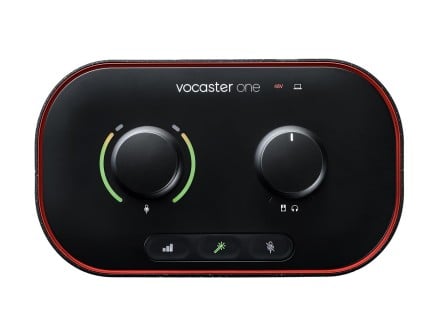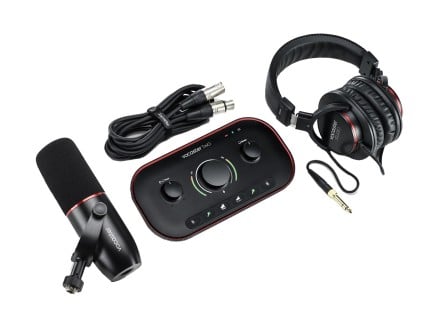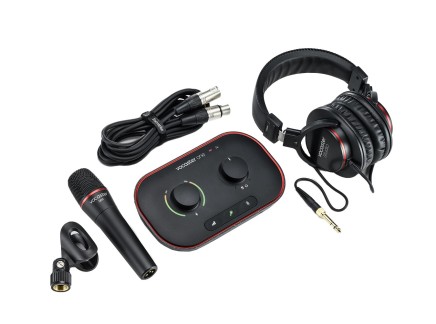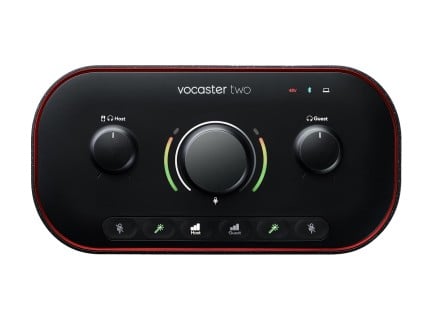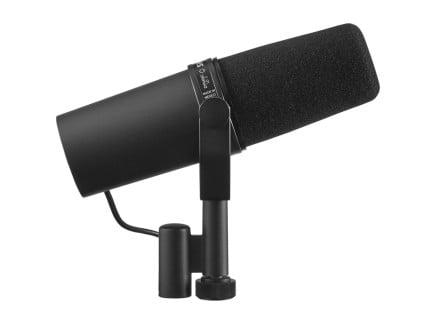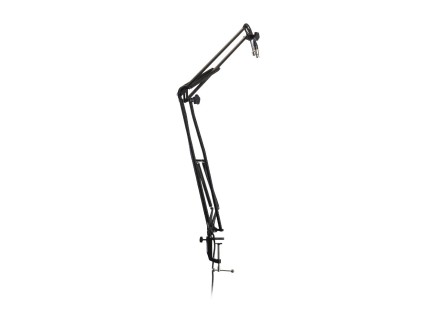There's an entirely new line of audio interfaces on the block—the Focusrite Vocaster series. Designed to be the perfect recording tool for podcasters and content creators of all kinds, it offers a number of convenient features you're not likely to find on other studio-oriented audio interfaces...so if you're working on launching your podcast or looking to take your streaming audio quality up a notch, these interfaces are well worth your consideration.
Of course, Focusrite has a long history of making spectacular audio interfaces. Their Scarlett series audio interfaces are among our top recommendations for burgeoning home studios and performers, and their Clarett Series extend the functionality of the Scarletts with even more pristine, crystal-clear sound quality. We wouldn't hesitate to recommend these interfaces to most any musician, regardless of style—Focusrite has truly honed in on a formula for producing reliable, feature-packed devices that suit everyone from singer-songwriters to electronic performers and producers with studios full of synthesizers or outboard gear.
So with all that said, Focusrite clearly has a strong track record and a reputation for quality. But now with multiple series of audio interfaces on the market, what makes the new Vocaster series such a good fit for content creators in particular? Let's take a look at the Vocaster One and Vocaster Two to get a sense of what they have to offer.
Focusrite Vocaster Series Overview
Focusrite's new Vocaster series includes the Vocaster One and Vocaster Two; Vocaster One features a single XLR mic input and headphone output, whereas Vocaster Two features two of each. Otherwise, these devices are quite similar, providing a small footprint, rugged build, and easy computer connectivity via USB-C. But there's much more to it than just that...so let's quickly look at what both interfaces have to offer.
The Vocaster interfaces are designed to give you broadcast-quality sound no matter where you are. Their high-quality mic inputs offer over 70dB of gain (that's a lot of gain)...meaning that you can use with any mic you like, even those that often require external signal level boosters. That means that you can instantly pair them with some of the world's most popular broadcast microphones, such as the Shure SM7B or Electro-Voice RE20, all without needing any extra gear. The Vocasters also provide 48V phantom power, so they also work great with condenser microphones.
But not only do the mic preamps have plenty of gain—they're dead simple to use. The Auto gain feature allows you to set your level in mere seconds: simply press the button and start talking, and it'll automatically adjust to the optimal level for your recording. And to take things even further, Focusrite has included an "Enhance" feature, providing you with four options of tonal presets designed to bring clarity and polish to your sound. Of course, you can manually adjust your levels and go without "Enhancement" if desired...but frankly, these features make it quite straightforward to dial in professional-quality sound.
The Vocaster interfaces also feature a number of niceties tailored specifically to address the logistics of podcasting, streaming, and content creation workflows. The front-panel mute button is always accessible—it mutes your input signal and making it simple to remove coughs, sneezes, or other unexpected interruptions. Moreover, in addition to their USB-C connectivity, the Vocaster series interfaces can be directly connected to phones or cameras via dedicated rear-panel connections. You can connect to your phone via a single TRRS cable, allowing you to capture audio from callers or to play music or other sound for your production. The camera connection allows you to send Vocaster's output straight to your camera via a single 3.5mm TRS cable, so that you can get high quality audio recorded directly into your video files. Couldn't be simpler. These interfaces also offer stereo loopback functionality...meaning that you can easily use audio from your computer directly on your show without the need for complex audio routing software. Nice.
With Focusrite's Easy Start tool, you'll be up and running in no time—and happily, all Vocaster packages come with everything you need to get started. Set your levels, audio routing, and enhancement settings using the Vocaster Hub software, and enjoy the included copy of Hindenburg Lite (and six-month Hindenburg Pro trial!), plus three months of SquadCast Pro + Video and six months of Acast Influencer.
Which Focusrite Vocaster is Right for Me?
Now for the device-specific details: both Vocaster interfaces feature dual 1/4" outputs for connecting to studio monitors or speakers of your choice, as well as a headphone output with a shared front-panel level control. The biggest differences between each model are that Vocaster One is designed for single-person shows, whereas Vocaster Two is better suited for two-person operations. So on Vocaster Two, you get everything you need for your co-host or in-person guests: a second XLR mic input and a second headphone output. Each input channel offers independent controls for auto-level, mic gain, enhancement, and even independent mute buttons—and both the host and guest have independent headphone outputs with their own respective level controls.
Moreover, Vocaster Two features Bluetooth connectivity for your phone, allowing you to capture audio from your phone wirelessly...quite convenient for phones that don't have a dedicated TRRS headphone connector. Otherwise, each interface offers the same features and same quality—so if you're going solo, Vocaster One should do the job. But if you have a co-host or frequently host in-person guests, you'll find the Vocaster Two more to your liking.
Also worth noting: Focusrite offers these interfaces in two pre-configured bundles: the Vocaster One Studio pack and Vocaster Two Studio pack. Each of these packs includes the other essential components you'll need to get your show started: studio headphones (HP60V), an XLR cable, and a microphone. The Vocaster One Studio Pack includes the Vocaster DM1, a handheld dynamic mic. The Vocaster Two Studio Pack, on the other hand, features the Vocaster DM14v—a classic broadcast-style dynamic microphone with built-in windscreen/pop shield.
So if you're truly starting from scratch and looking to build your content creation studio workflow...no doubt one of these packages will be perfect for you. Just add a mic stand or desktop boom arm and you're off to the races!
Focusrite Vocaster: Hit the Ground Running
Truly, if you're just getting started in the world of podcasting and streaming, these interfaces are a no-brainer. They'll make all the setup you need so simple—and while you can achieve many of these functions with other audio interfaces, it'll require a ton of setup and troubleshooting. Focusrite has made it easy by giving you a device tailor-made for your needs...so if you're ready to get your content out there, we can't think of a more immediate and valuable tool. Don't let tech get in the way of your process: with Vocaster, you can stop worrying about technical details and get straight to work.








